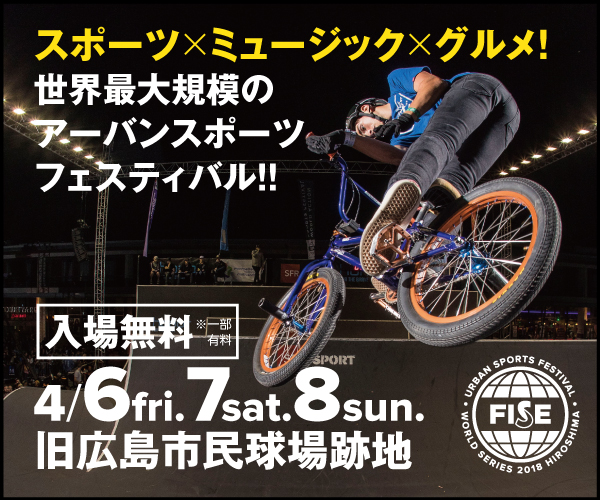Bringing a new wind to the culture of Nishijin textile! “Bank of Craft” introduces a new charm of Nishijin textile fused with “Street culture”.
J&J Business Development Corp. established the project called “Bank of Craft”, which promotes the use of traditional crafts in the regional ecosystem by fusing creative works, art, and digital technology to develop tourism resources, solve regional issues, and create a new primary resource of revenue in craft production areas, rather than just maintaining the value of the craft as a product.
As the first edition of this project, Kyoto Nishijin Textile, FINEPLAY, 430(Four-Thirty),and CURRENT have joined this collaboration to create premium skateboards and kendamas, which are now on sale.
In this article, we interviewed Kentaro Yasuda, the CEO of Yasuda Corporation., Soichiro Imagawa, the president of Kiyata Imagawa Orimono Co., and Sakio Ohba, the president of Kyoto Nishijin Oba. They are in charge of the design production of this project and also are the members of N180 (Nishijin One Eighty), a group that promotes new culture in the Nishijin.
We are honored to have central figures of this project that crosses over the two different cultures between Japan’s world-class traditional culture and street culture which originated from the West. We asked them about the historical background of the Nishijin Textile, the challenges they face, and their thoughts behind the unique collaboration of “Urban Sports x Nishijin Textile”.
Kentaro Yasuda (Hereinafter: Yasuda)
Soichiro Imagawa (Hereinafter: Imagawa)
Sakio Ohba (Hereinafter: Ohba)
Historical background of how “diversity” became a characteristic of Nishijin Textile
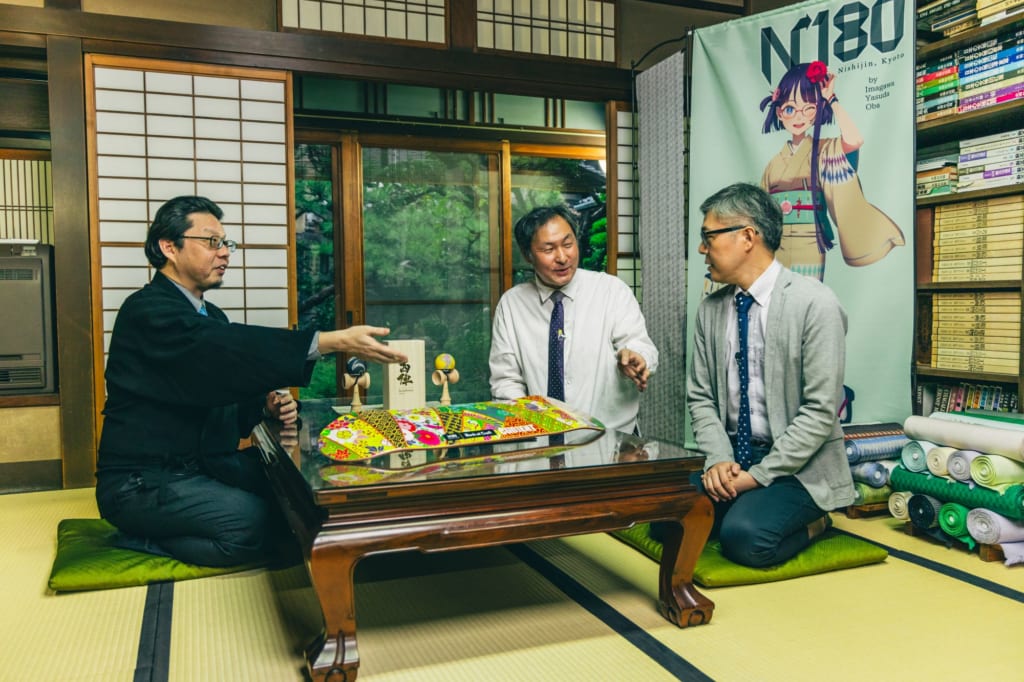
The history of textiles in Kyoto began about 1,200 years ago when the first people arrived in Japan. So this traditional craft has a very long history, including the period when Kyoto was the capital of Japan.
Since Nishijin textile craftsmen in Kyoto have dealt with the detailed needs of the wealthy class such as the so-called noble family and royalty, this industry has built a system to tailor to detailed requests and needs from customers.
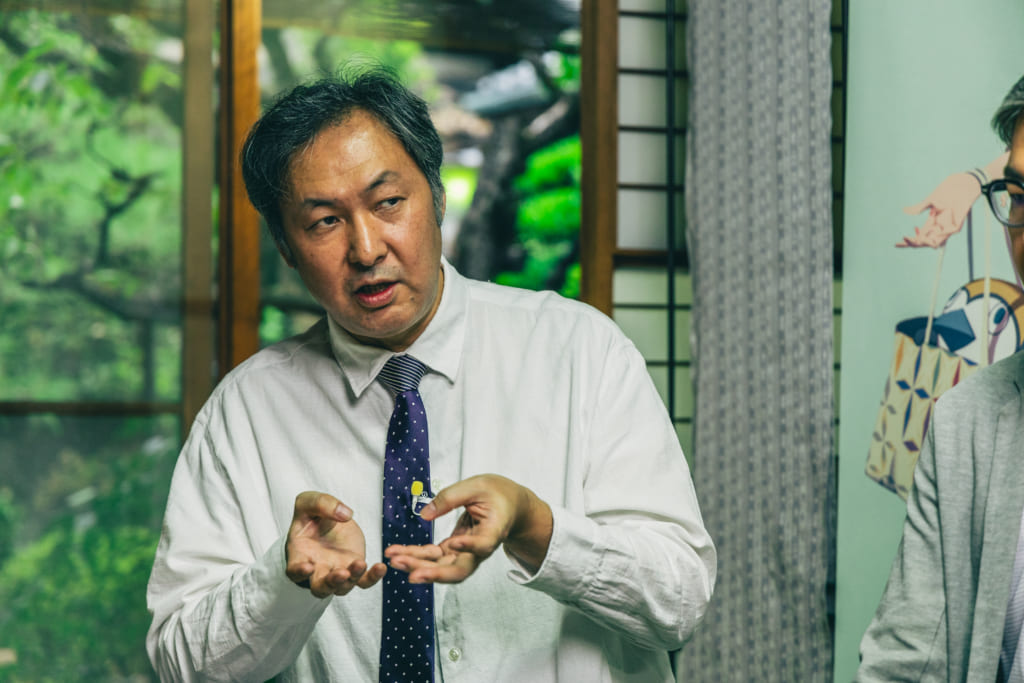
This system is enabled by “division of work”, which means that the work is allocated to specialists in each process. This “division of work” is quite characteristic of Nishijin textiles craftsmanship and its own “diversity”, Soichiro Imagawa said.
Imagawa: Back in the days when all Japanese wore kimonos, kimonos were not treated as special clothing but had various uses ranging from everyday wear to ceremonial wear.Nishijin textile manufacturers made obis and kimonos to meet those needs, so it was not a matter of them “preserving some tradition” but rather creating more products that fit the background of the times. In this process, the “division of work” was developed to make it more efficient as an industry, and specialists in each process came out and expanded the “diversity” of products to be made. This is a historical backdrop that the Nishijin Textile industry has travelled.
Challenges facing the “Modern” Nishijin Textile

Over time, however, the Nishijin textile industry has faced many challenges. One of the most serious problems is a lack of successors.
In the division of work that has supported the diversity of the Nishijin textile, even if only one specialist in each process ceased to exist, the entire process would come to a standstill.
So Nishijin textile manufacturers are trying various measures, such as training successors from younger generations among themselves. However, the current problem is that they are unable to keep up with the speed at which the scale of their business is shrinking.
To solve these problems, an organization called “N180” was launched to promote a new culture of Nishijin textile.

Mr. Sakio Ohba, the president of Kyoto Nishijin Ohba, the only textile manufacturer in Japan that uses “Tsuzura-yarn,” said the following.
Ohba: In the face of such problems, we started an organization called “N180”. The reason why we chose the word “180” in the name of this group is that it means to turn things upside down so we want to change this current situation under the name. We also have a YouTube channel and are working on letting fans know about the current situation that the kimono production area is facing and the appeal of obis and kimonos from the perspective of their manufacturers.
The feelings behind “Nishijin Textile x Urban Sports”
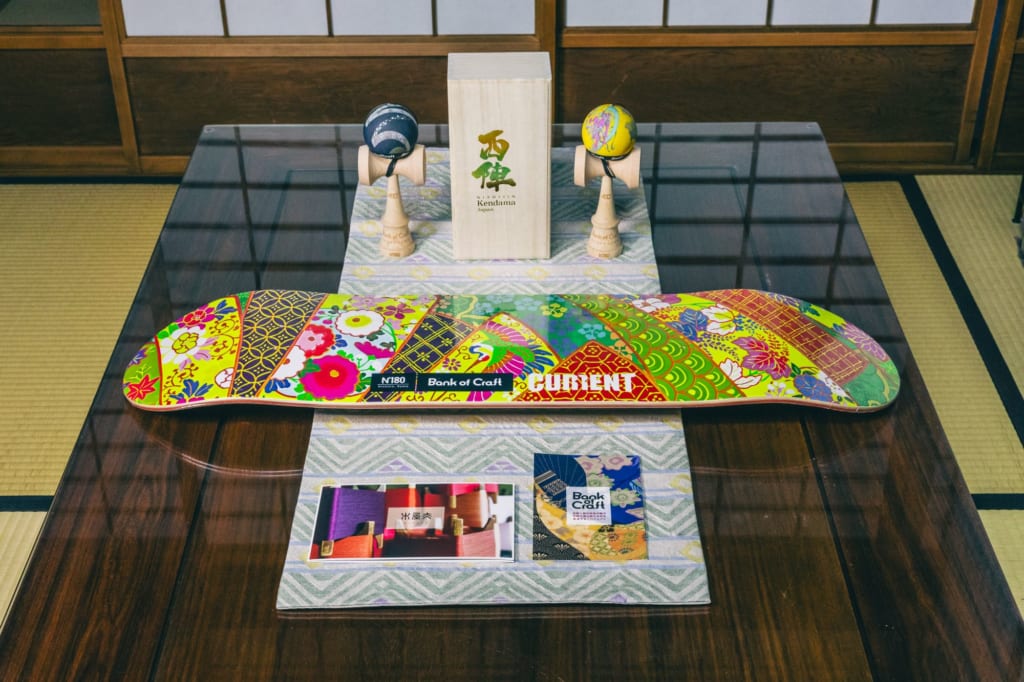
The activities of N180 were the catalyst for this “Bank of Craft” project. Mr. Imagawa and the members of N180 thought it was about time to create a new product so made a decision like “We have to get on board!”. And he added,
Imagawa: We simply like interesting and new things (laughs). And we joined this project because it was completely linked to what we have wanted so we had no choice but to get on board.
While such kimonos have a strong top-down cultural element, on the other hand, I think street culture is truly a bottom-up culture so we were very excited to see how Nishijin textiles could be introduced and accepted in a completely different world.
New charm of Nishijin textile is now introduced by new approaches
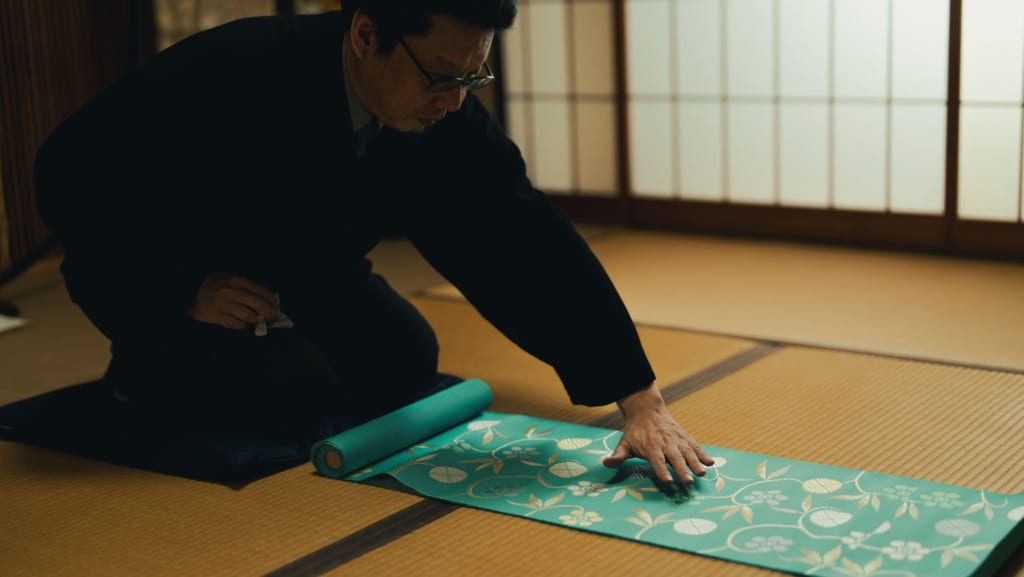
In everyday production, it is difficult to balance the two elements of “art” and “product” when thinking about its design within the canvas of obi or kimono.
However, “It was stimulating for us to have an offer with this kind of design because it allowed me to challenge myself from a different angle,” said Mr. Kentaro Yasuda, the president of Yasuda Co.
And he also added with his impression of this unique collaboration as follows.
Yasuda: Kendama is originally a Japanese game but recently has become a worldwide sport, and I think it is very interesting that kendama with Nishijin patterns is spreading to the world. On the contrary, skateboarding is a culture that originated in the U.S., and I think it is very cool to see the precise patterns of Nishijin textile on the back of skateboard decks when skaters perform various tricks.
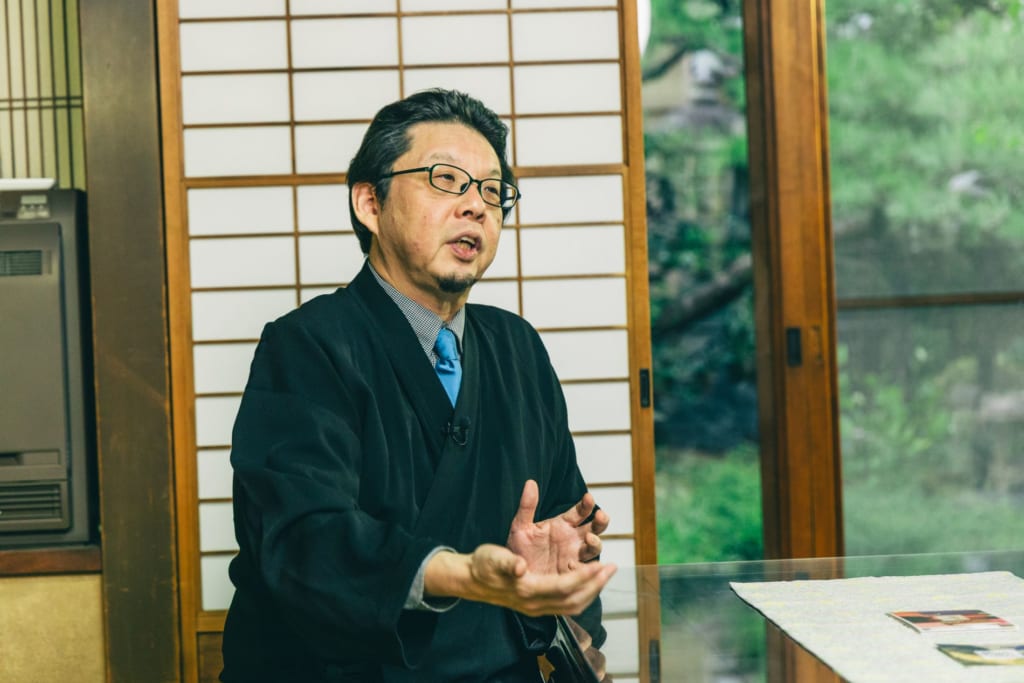
Finally, Mr. Ohba shared his impressions of the products and his vision for the future.
Ohba: While we design kimonos and obis, it was a fresh surprise to see the different points of view that the designers in other genres focus on when we turn our design into products. Nishijin textiles have a long history and have produced many designs in the past, but I have a hope that other designers and different points of view will show us new charms so I would like to see more new collaborations in the future!
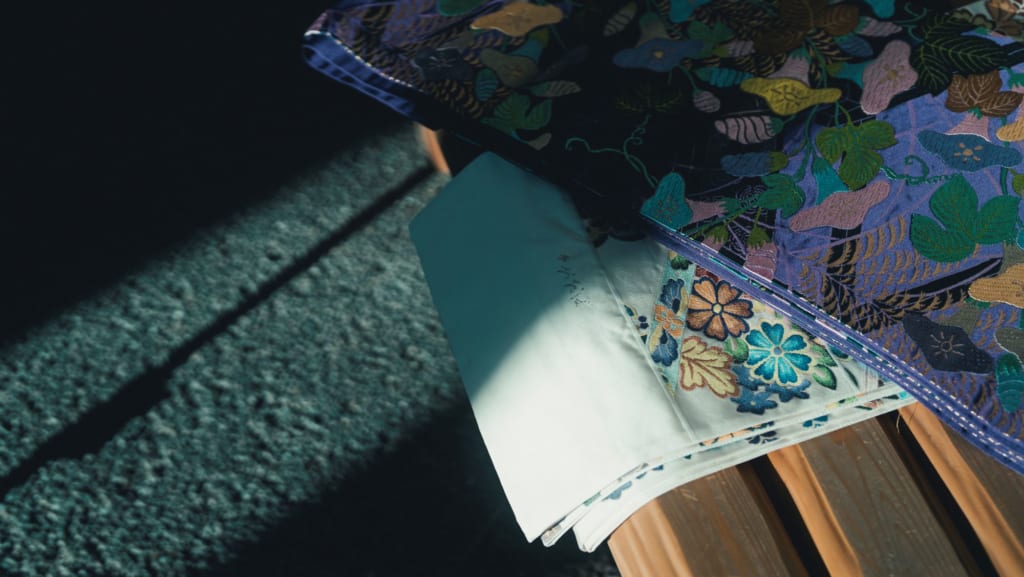
Since the Nishijin textile production area has various historical backgrounds, this kind of new contemporary initiative will probably bring a new wind to the traditional craft production areas throughout Japan.
We will continue to stay tuned with the development of “Bank of Craft” project and new expressions that come with traditional crafts in the future.
These products can be purchased online from the FINEPLAY EC site so everyone including skaters, kendama players, and collectors in Japan can enjoy this unique collaboration of traditional craft design “Kyoto’s Nishijin-ori” and urban sports. Please check them out.
Product Information
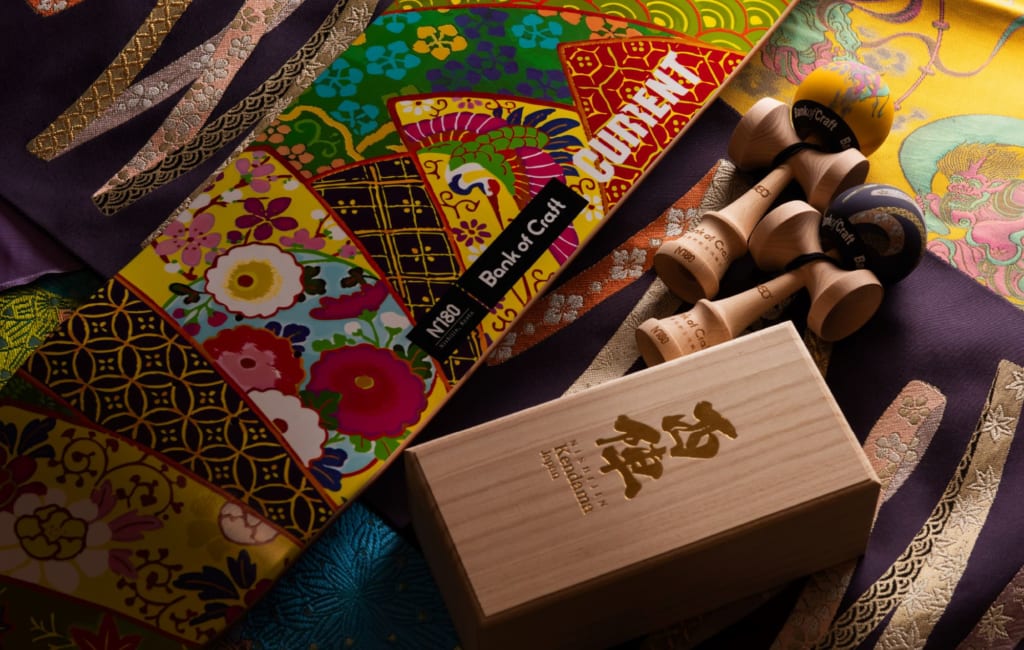
Traditional Craft Designed Skateboard & Kendama Full Package
*Only 10 sets available
This full package includes the collaboration skateboard with “Nishijin textile (Kyoto)” and the skateboarding media “CURRENT”, and the collaboration kendama with “Nishijin textile (Kyoto)” and “430 (Four-Thirty)” known as the leader in Japanese kendama culture.
Price: 35,000 yen (38,500 yen – tax included)
<Traditional craft designed skateboard and Kendama Full Package>
-Traditional craft designed kendama “Wind God and Thunder God”
-Traditional craft designed kendama “Noe Tanzaku”
-Traditional craft designed skateboard “Keijuhakuohbun”
<Special Gift for those who purchase the full package>
An original NFT (Until March 31, 2024) , a Bank of Craft limited edition not-for-sale T-shirt and an original strap will be given as a special gift to those who purchase the full package!
*The Bank of Craft limited edition T-shirt is only available in size L.
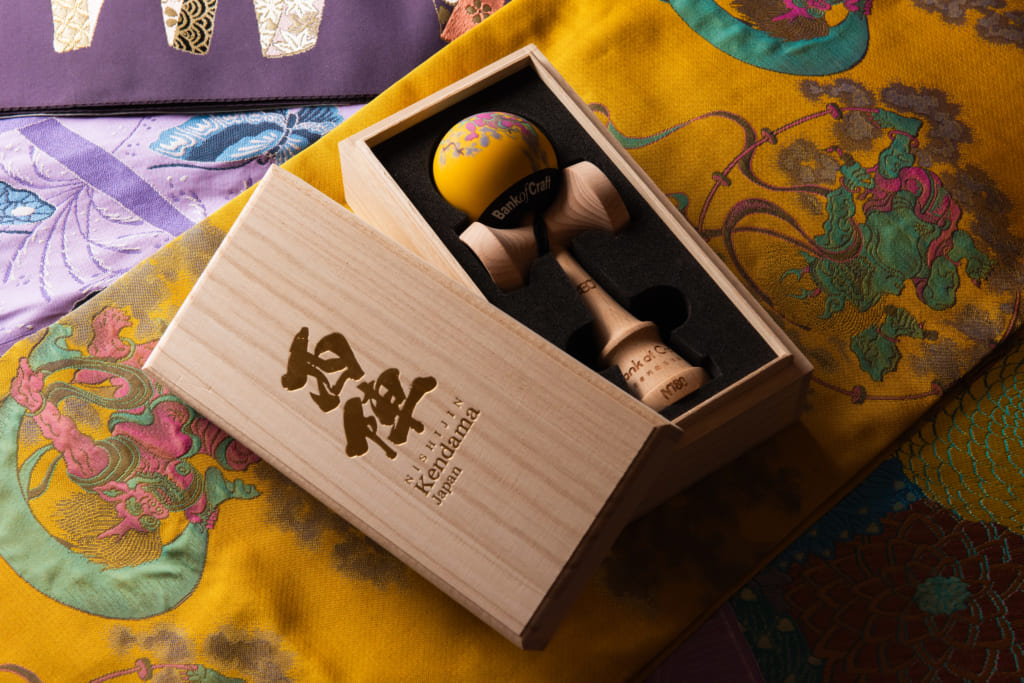
【Bank of Craft×Nishijin textile×430】
Traditional craft designed kendama “Wind God and Thunder God”
This kendama is made in collaboration with Nishijin textile (Kyoto), a traditional Japanese craft design, and “430 (Four-Thirty)”, the leader of Japanese kendama culture. The Sarado is enlarged compared to the regular one so that both beginners and experts can handle it, and the size of the ball hole is also adjusted to larger size specifications. The soft and splendid beech material used for the product allows the users to enjoy how the material ages by the texture and visual appearance. This product is also packaged in a special paulownia box so you can enjoy a luxurious look as an interior accessory by keeping it in the box.
Price: 12,700 yen (13,970 yen – tax included)
※This price is set per item.
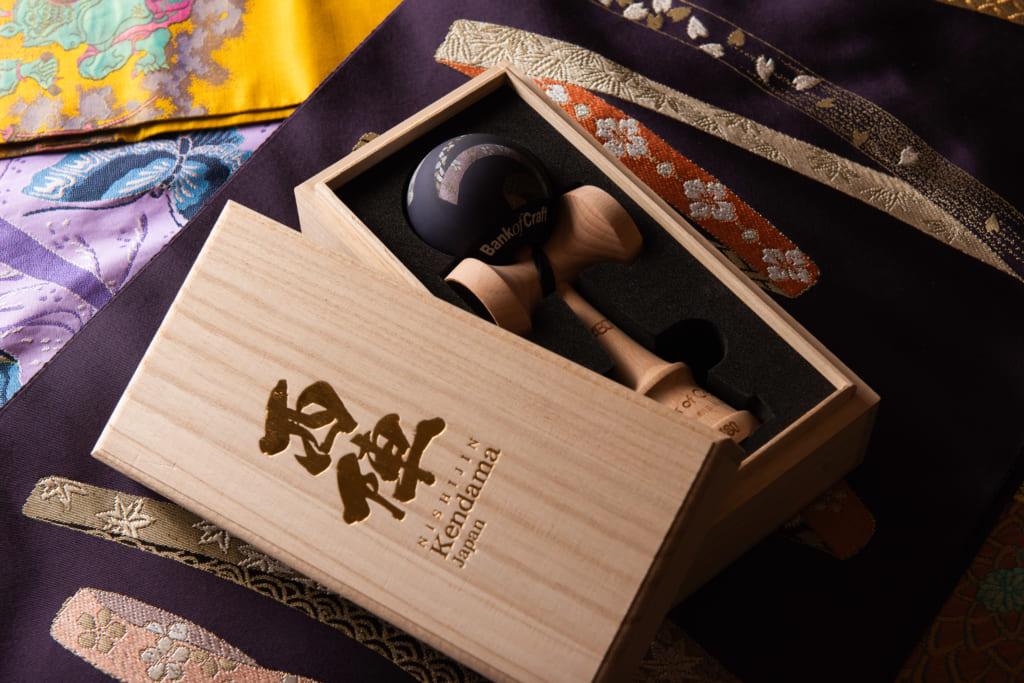
【Bank of Craft×Nishijin textile×430】
Traditional craft designed kendama “Noe Tanzaku”
This kendama is made in collaboration with Nishijin textile (Kyoto), a traditional Japanese craft design, and “430 (Four-Thirty)”, the leader of Japanese kendama culture. The Sarado is enlarged compared to the regular one so that both beginners and experts can handle it, and the size of the ball hole is also adjusted to larger size specifications. The soft and splendid beech material used for the product allows the users to enjoy how the material ages by the texture and visual appearance. This product is also packaged in a special paulownia box so you can enjoy a luxurious look as an interior accessory by keeping it in the box.
Price: 12,700 yen (13,970 yen – tax included)
※This price is set per item.
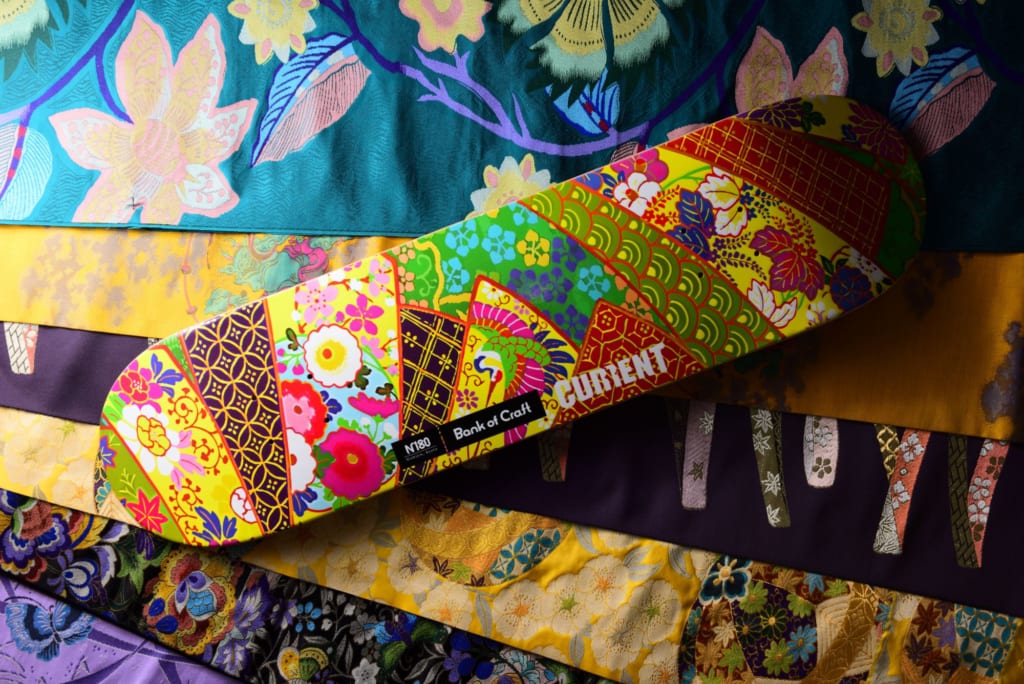
【Bank of Craft×Nishijin textile×CURRENT】
Traditional craft designed skateboard “Keijuhakuohbun”
This skateboard is created by Bank of Craft, a project that aims to reconstruct the value of traditional crafts and arts, and to inherit and develop traditional crafts by taking advantage of its techniques and shaping them to suit modern life through some development and crossover under their mission of building a new business model of traditional crafts and arts,This product is made in collaboration with Nishijin textile (Kyoto), a traditional Japanese craft design and skateboarding media “CURRENT”.
Price:15,000 yen (16,500 yen – tax included)
SPECIAL EDITION

FINEPLAYはアクションスポーツ・ストリートカルチャーに特化した総合ニュースメディアです。2013年9月より運営を開始し、世界中のサーフィン、ダンス、ウェイクボード、スケートボード、スノーボード、クライミング、パルクール、フリースタイルなどストリート・アクションスポーツを中心としたアスリート・プロダクト・イベント・カルチャー情報を提供しています。
アクションスポーツ・ストリートカルチャーの映像コンテンツやニュースを通して、ストリート・アクションスポーツの魅力を沢山の人へ伝えていきます。
●今日 ○イベント開催日
-
dance世界王者の座は挑戦者に。B-Boy ShigekixとB-Girl Royalが世界選手権初優勝「東急不動産ホールディングスWDSF世界ブレイキン選手権2025久留米」2025.12.152025年を締め括る、世界一を決める世界最高峰の1on1ブレイキンバトル 2025年12月12日(金)〜13日(土)の2日間に渡り、福岡県久留米市にて「東急不動産ホールディングスWDSF世界ブレイキン選手権2025久留米」が開催された。本大会は、WDSF(世界ダンススポーツ連盟)公認の世界選手権として日本国内で初めて開催されたこともあり、ブレイキンの強豪国であるこの日本でのタイトル獲得に燃えたトップブレイカーたちが世界中約40カ国から集結。2025年を締め括る世界最高峰のブレイキンの熱いバトルが繰り広げられた。 決勝日には観客が会場一杯に 本大会コンセプトは “ONE STEP CAN MOVE THE WORLD”。老若男女経験問わず大会観戦を通して『自分も何か始めてみたい』と思ってもらえるように、会場では観客も一体となって盛り上がるライブ感あふれる演出も用意されるなど、観客の手拍子や歓声から生まれる熱量が、選手たちのパフォーマンスをさらに加速させていた。 また日本初開催である本大会では、世界中から来日した選手たちが万全な状態で試合に挑めるように手厚いサポートが与えられた。その中でも大会スポンサーであり長年日本代表選手たちのサポートを行う、味の素株式会社様からは選手たちの補給食が用意された。 味の素株式会社提供の補給食の数々 そしてさらに本大会を盛り上げるべく、久留米市内では大会キービジュアルの屋外広告を周辺駅構内などの人の目に付くエリアへ掲載。街全体で大会をサポートしている様子が見られ、その甲斐もあってか決勝日のチケットは全てソールドアウト。来場者数は3,500名に達し、会場は最大級の熱気に包まれていた。 アーバンスポーツ体験エリア また会場入口付近ではサイドコンテンツとして、全国の若手ダンサーが躍動するダンスステージや、BMX、パルクール、ジャンプロープ、フリースタイルバスケットボールを含めたアーバンスポーツ体験エリアを展開。日が落ちると光と音の演出で盛り上げるNEON STREET PARKが同時開催され、未だかつて見たことないアーバンスポーツと光と音のコラボレーションに観客は終始目を奪われていた。 ブレイキンを通して「新しいことに挑戦したい!」という思いを後押し「MIZUHO BLUE DREAM BREAKING LIMITS WorkShop」特別編 ワークショップの様子 昨年2024年からスタートし、全国の小中学校で大好評のB-Boy Shigekixとみずほフィナンシャルグループによるブレイキンワークショップツアー「MIZUHO BLUE DREAM BREAKING LIMITS WorkShop Tour」のスピンオフ企画としてスペシャルワークショップが大会2日間にわたり開催された。 今回設けられたブースでは初心者から経験者まで多くの子どもたちや親子連れが参加。実際にShigekix監修のレッスン映像を視聴した上で、インストラクターと共に各ムーブにトライした。本ワークショップではトップロック(ツーステップ)、フットワーク(CC)、フリーズ (チェア)の3つのムーブを学んだ。映像ではムーブをステップバイステップでレクチャー。正面や背面、側面など様々な角度からムーブを見せたり、かっこよく踊るための注目ポイントも教えるなど充実したプログラムとなった。 ワークショップの様子 ムーブの細かい点に関してはインストラクターがその場でサポート。終始参加者の列は途切れず、子どもたちだけのグループはもちろん、親子でトライする回もあり、中にはインストラクターをも唸らせるムーブを見せるキッズB-Boyもいたりと、お互いのスキルを見せ合いながら交流する子どもたちの姿も垣間見れた。 ワークショップ後にはShigekixサイン入りパネルのあるフォトブースで集合写真を撮るなど、和気藹々と時間を過ごしていた。記念品としてワークショップやSNSキャンペーンで参加した方にはオリジナルキーホルダー、フォトブースで写真を撮った方はクリアファイルが手渡され、思い出を一緒に持ち帰られる施策に参加者はみんな満足した様子だったのも印象的だった。 本ワークショップでは、レッスン映像内でShigekixが話していた通り、「ブレイキンを通して新しいことへ挑戦する」大切さを伝えることを目的にしており、実際に多くのキッズが各々ブレイキンに挑戦する機会となった、まさに大会コンセプトである“ONE STEP CAN MOVE THE WORLD”にぴったりなワークショップだった。 世界トップランカーや若手精鋭が揃い踏み。豪華すぎる選手ラインナップ 選手宣誓をするB-Boy Jeffro 本大会には世界約40カ国から約180名のB-Boy・B-Girlがエントリー。決勝日当日は前日の予選、TOP64、TOP32、TOP16までの4試合を勝ち抜いたB-Boy 8名、B-Girl 8名が登場。世界の強豪選手がひしめく中、日本からは男女ともに5名が進出し母国開催で強さをアピールする大会初日となった。 B-Boy ISSIN なお男子のTOP8には、パリオリンピック日本人最高位の4位であり、昨年の世界選手権準優勝のワールドランキング1位のB-Boy Shigekixを筆頭に、昨年の世界選手権で優勝し今年の「Red Bull BC One World Final Tokyo 2025」の優勝者であるB-Boy ISSIN、パリオリンピックの日本代表でパワームーブが世界から高い評価を受けるB-Boy Hiro10、国内外の大会で活躍する次世代のホープであり世界トップクラスの回転技を持つことで注目を集めるB-Boy Tsukki。そして同じく若手の注目株であり自身の独特な世界観をダンスに落とし込み他を圧倒するB-Boy RA1ONが進出。彼らに相対するのは、2023年度の世界選手権優勝者であり、パリオリンピック銅メダリストであるアメリカ合衆国代表のB-Boy Victor、同じくアメリカ代表選手でパリオリンピック5位の実力者B-Boy Jeffro、そしてフットワークのスキルの高さと独特なダンススタイルが特徴的なB-Boy Dias (カザフスタン)という面々となった。 B-Girl RIKO 一方、女子のTOP8には、パリオリンピック日本人最高位の5位であり日本の女子ブレイキンシーンを牽引するB-Girl Ayumiをはじめ、B-Boy Shigekixの姉で今年の全日本選手権の王者であるB-Girl AYANE、今年の「Red Bull BC One World Final Tokyo 2025」の優勝者であり国内外の大会で活躍するB-Girl RIKO。そして今年国内予選から勝ち上がり「Red Bull BC One Last Chance Cypher」まで進出した若手B-Girl Cocoa。さらに同じく若手でスタイリッシュなフットワークとパワームーブが特徴的なB-Girl HIYOが日本から勝ち上がった。 そんな彼女たちとマッチアップを繰り広げるのは、今年の「Red Bull BC One World Final Tokyo 2025」の準優勝者でパリオリンピック銀メダリストであるB-Girl Nicka(リトアニア)、パリオリンピック7位で様々な世界大会で頭角を表すB-Girl Syssy(フランス)、そして昨年の世界選手権では7位になるも、今年のユース世界選手権では優勝を果たし、勢いのある中で今大会に挑んだB-Girl Royal(中国)。 パリ2024オリンピックのトップ選手から今年の「Red Bull BC One World Final Tokyo」の入賞者まで最近話題のB-Boy・B-Girlが勢揃いしたことで、国内外から注目が集まり、まさに2025年を締め括るのに相応しい大会となった。下記はその今年の世界一を決める大会のTOP8以降のバトルレポートである。 世界の舞台でも見られた新時代の幕開けの瞬間。並いる強豪を倒し、ニューフェイスのB-Girl Royalが優勝 決勝でのB-Girl Royalのムーブ B-Girlサイドは、TOP8でパリオリンピック7位のSyssy、現全日本王者であるAYANE、「Red Bull BC One World Final Tokyo 2025」の優勝者のRIKO、「Red Bull BC One Cypher Japan 2025」の優勝者Cocoaなど、優勝候補といってもおかしくない実力者たちが次々と姿を消す波乱のトーナメントに。 そんな戦いを勝ち上がったTOP4は日本人選手vs海外選手という構図。1戦目はRoyal vs HIYO。お互いに緩急を付けた上下のオリジナルな動きとフローで争うも、RoyalがHIYOをストレートで破る。トーナメント反対の山の2戦目ではAyumi vs Nickaという世界トップクラスで様々な好成績を残している二人のカード。Nickaが高度なテクニックを有したムーブでAyumiに襲いかかるも、ここはよりクリエイティブかつミュージカリティを掴んだフローを見せたAyumiが決勝へ駒を進めた。 3位決定戦でのB-Girl Nickaのムーブ 3位決定戦は、TOP4で惜しくも決勝を逃したHIYO vs Nicka。ハイレベルかつよどみないフットワークからのパワームーブのフローで攻めるNickaと、音を上手く取るトップロックからパワームーブとフリーズに持ち込むHIYO。どちらもハイレベルなルーティンを見せつけたが、今回はパワームーブからフリーズなど様々なバリエーションの高難度ムーブを上手く盛り込んだNickaに軍配が上がった。 決勝でのB-Girl Ayumiのムーブ 決勝は、昨今のブレイキンシーンで見られることが多くなった若手対ベテランの戦い。今年のユース世界選手権で優勝しノリに乗る若手Royalと、長年ブレイキンシーンを牽引し世界大会で多くのタイトルを勝ち取ってきた日本を代表するトップブレイカーのAyumiが対戦。テクニカルで唯一無二のオリジナリティをフロアムーブで見せるAyumiに対して、パワフルかつキレのあるハイレベルなパワームーブを中心に勢いのあるルーティンを見せるRoyal。スタイルの違う二人がぶつかり合い、手に汗握る戦いとなったが、今回は若手の注目株であるRoyalが見事初優勝を果たした。 B-Boy Shigekixが自分の魂を乗せたパフォーマンスで自身初の世界選手権の頂点へ 決勝でのB-Boy Shigekixのムーブ 一方、今回のB-Boyサイドは日本人選手たちが強さを見せる中、日本人同士のマッチアップだからこそ見られたストーリー性に満ちたバトルが続いた。その中でもTOP8で特に会場を沸かす戦いを見せたのはISSIN vs Tsukkiのバトル。お互いが豪快なパワームーブを強みとする中、先攻で出てきたISSINの2000にTsukkiが1990を合わせるなどラウンド1から盛り上がる展開に。Tsukkiは超ハイレベルなスピンや難しい軸でのパワームーブで攻めて会場を終始沸かせるも、今回はトータルパッケージで勝ったISSINに軍配。ただこのバトルも今後ストーリーが紡がれていくような一戦となった。 TOP8でのB-Boy ISSINのムーブ またTOP4で印象的だった戦いは、XII After Oursという同じクルーで活動しているShigekixとRA1ONのバトル。お互い得意とするスタイルが違う一方で、普段から一緒に練習することも多い二人。どんなムーブをしてくるのかも想像できるからこそ、双方の気持ちの強さが激突したバトルとなった。結果は2:1でShigekixが決勝に駒を進めた。 TOP4でのB-Boy RA1ONのムーブ 3位決定戦はHiro10とRA1ONの対戦。先攻で飛び出したのはRA1ON。DJの流す音に上手くはめながらミュージカリティとスタイルの溢れるムーブで緩急を付けたパフォーマンスを展開。一方、Hiro10はキレのあるパワームーブとフリーズでルーティンを見せていく。その中でもHiro10が最終ラウンドで見せたウィンドミルからの2000では、フロアの中心から端まで移動し落ちるかどうかのギリギリのところで止まるというハイレベルなムーブを見せ、対戦相手のRA1ONを含めて会場全体を大きく沸かした。そんなムーブも相まってか今回の3位決定戦はHiro10が制し、銅メダルを勝ち取った。 3位決定戦でのB-Boy Hiro10のムーブ そして今回の決勝カードは、昨年の世界選手権決勝と同じ顔合わせ。昨年の世界選手権優勝者のISSINと、準優勝者のShigekixのリマッチとなった。先攻でバトルの口火を切ったのはShigekixで1ムーブ目から魂を乗せたキレのある音にしっかりはめたパワームーブやフリーズを見せて大きく会場を沸かせる。対抗するISSINもスタイリッシュかつ豪快なアクロバットも含めたオリジナルムーブで応戦。しかしShigekixは勢いそのまま最終ラウンドまでパワフルでバリエーションに富んだパフォーマンスを続け2:1でISSINを撃破。数々の世界大会でタイトルを獲得してきたShigekixがまだ手にできていなかったこの世界選手権の舞台で悲願の初優勝を飾った。 Shigekixコメント「今回優勝できたのは挑戦者として挑めたから」 B-Boy Shigekix 今日の感想を教えてください。世界選手権ではまだタイトルを取れていなかったので「初優勝を掴み取りに行く」という意気込みで挑んだ中、自分のやってきたことをしっかり発揮できるパフォーマンス力や勝負強さに対して自分自身掲げていたテーマがあったので、今回のタイトル獲得はすごく嬉しいです。ただ来年の同大会を迎える頃に自分がどうなっているのかまで目を向けると、今回のパフォーマンスも自分自身100点満点ではなかったなと良い意味で感じています。その伸び代も含めて、今回一番良かったのはとにかく「チャレンジャー」という気持ちを持って各バトルに挑めたことだと思います。 来年はアジア大会がありますが、今回出場権を獲得できたので今後もしっかりと挑戦者として挑めるよう、自分を心から奮い立たせるものを大切にしていきたいと思っています。 今大会で勝てた要因はなんだと思いますか?現在、ブレイキンの技術が世界的に日々レベルアップしている中で、アイデンティティやスタイルをしっかり構築してきたダンサーと対峙した時に、自分が相手を凌駕できるのか。そのような「オンリーワン同士のナンバーワン決定戦」がこのブレイキンのバトルトーナメントだと思います。 そのバトルの中で大事になってくるのは最後まで戦い抜く「粘り強さ」だと思います。スタイルが最大限発揮できている瞬間っていうのは、技術や戦術はもちろんですが、身体がしっかり準備できていることがすごく大事で、本当に1ミリの勝ち負けに作用しているのが、その力強さや粘り強さだと感じています。今回は自分自身すごく強い気持ちを持って挑めたので、その強さがメンタル面にも出ていたと思いますし、「自分の魂に自分の踊りがついてくる感覚」もあり、フィジカルの部分も含めて「3ラウンドどころか5ラウンドぐらいいけるんじゃないか」と思えるような気持ちで挑めたところが良かったと思います。 仲間と優勝を喜び合うB-Boy Shigekix 現在はクルー活動やD.LEAGUE参戦、日本全国でのワークショップなどブレイキンを通じて様々な活動をしていますが、この世界選手権優勝は今後の活動にどう活かされると思いますか?現在ブレイキンを通して色々な活動をさせていただく中で、スケジュール的に忙しくなってしまっても、プレイヤーとしては変わらず今まで通り練習もハードにやる必要はあります。でもそのモチベーションになっているのが他の様々な活動です。全国の学校訪問ではブレイキンワークショップを通して「夢や目標に向かって全力で挑むこと自体がかっこいい」「一緒に頑張ろう」ということを大きなテーマにして授業させていただいています。 そのテーマを伝える上で、僕自身すごく大事にしていることが「自分もそれを体現する」こと。 やっぱり彼らに「頑張ろうね」と言っている分、自分が頑張っている姿を見せたいですし、「あの時に授業に来てくれたお兄ちゃんが頑張ってるなら、私も/僕も頑張らないと」と思わせられる、そんな存在であり続けたいと強く思っています。僕自身、現役選手だからこそ伝えられるものがあると思いますし、今大会にも実際に現地へ足を運んでくれた子たちも多かったので、彼らにとって親近感のある「身近なヒーロー」として、その背中を見せたいという気持ちがすごく強かったので優勝できて良かったです。今後も挑戦し続ける姿を見せられるように頑張ります。 Royalコメント「今後も自分自身と向き合い続けて成長していきたい」 B-Girl Royal 今日の感想を教えてください。つい2週間前に中国国内で大会があったこともあり、今大会への準備はあまりできていなかったので、大会初日の昨日は少し緊張しすぎているなと感じていましたが、今日はこの環境にも慣れて、自分の実力を発揮することができました。 今大会で勝てた要因はなんだと思いますか?自分のダンススタイルと音楽を上手くマッチすることができたのはひとつ勝てた要因だと思いますが、今大会で意識していたことは自分のスタイルを表現することでした。決勝では自分のオリジナルのスタイルをしっかり発揮できたと思います。 今後の目標を聞かせてください。昨年の世界選手権から、自分自身この1年間でどれだけ成長できたのか気づけていませんでしたが、1年間を通して海外の様々な試合に参加して経験をたくさん積めたことで自信を持って今大会に臨むことができました。今後も他の選手に勝つことではなく自分自身と向き合いながらもっと成長していきたいと思っています。 大会リザルト 左からAyumi、Royal、Nickaの順 B-GirlGold:Royal(郭 朴) / CHN(中国)Silver:Ayumi(福島 あゆみ)/ JPN(日本)Bronze:Nicka(Dominika Banevi)/ LTU(リトアニア) 左からISSIN、Shigekix、Hiro10の順 B-BoyGold:Shigekix(半井 重幸)/ JPN(日本)Silver:ISSIN(菱川 一心)/ JPN(日本)Bronze:Hiro10(大能 寛飛)/ JPN(日本) 日本初開催の世界選手権を経て、日本人選手たちが向かうのは名古屋の地で行われるアジア大会 日本国内では初開催となった世界ダンススポーツ連盟(WDSF)公認の世界選手権。まさに世界最高峰の戦いが繰り広げられ2025年が締め括られた。そして日本人選手にとっては、本大会でTOP3に入り、かつ最上位となったB-Boy・B-Girl各1名が2026年9月に愛知県名古屋市で開催の第20回アジア競技大会への出場資格を獲得できることから、今大会で優勝したB-Boy ShigekixとB-Girl Ayumiが出場権を獲得。来年もここ日本で大きな国際大会が開催されるこのブレイキン。今後も日本人選手たちの活躍はもちろんのことブレイキンシーンのさらなる発展に目が離せない。
-
skate涙の女子決勝と讃えあう男子決勝「ワールドスケートボードストリート2025北九州 – グランドファイナル – 」大会レポート2025.12.06福岡県北九州市小倉の北九州メッセにて2025年11月26〜30日に開催された「ワールドスケートボード ストリート 2025 北九州」。本記事では最終日に行われた女子決勝と男子決勝についてレポートしていきたい。 女子決勝レポート 準決勝から勝ち上がった日本勢は赤間凛音、松本雪聖、織田夢海、大西七海。 中国からツゥイ・チェンシーとジュー・ユアンリン。韓国からはシン・ジユル。 オーストラリアのクロエ・コベルの8名。 今大会で目を引くのはアジア圏の圧倒的強さである。中国には現在、成都という街がスケートパークやイベントに力を入れ、韓国でもストリート文化の急速な発展、オーストラリアのゴールドコーストにはクロエ・コベルのためを思って作られたPizzey Park Skateparkがあるという国それぞれの背景を持つのも興味深い。 表彰台に上がった3名と筆者が気になったスケーターの計4名について紹介していく。 松本雪聖 ©︎Kenji Haruta / World Skate 8名の入場時、会場からの声援が一番大きかった彼女。 ベストトリックでは唯一バンクからの飛び出しセクションにて「キックフリップフロントサイドノーズグラインド」をラストにメイクし地元九州での逆転優勝を飾った。 地元九州での開催に多くの友人が駆けつけた今大会。プレッシャーを感じていたか優勝が決まった瞬間には涙するシーンに会場からは温かい声援に包まれた。 得意とするキックフリップと超越する跳躍力はロサンゼルスの地でも羽ばたくに間違いない。来年の彼女の滑りにさらに注目したいと思わせる今大会であった。 織田夢海 ©︎Kenji Haruta / World Skate 1本目のランを完遂した彼女はラン2本目でラストトリックを「キックフリップ50-50グラインド」に変えてさらなる高得点を獲得。ラン中には女子ではあまり見られないレールでの「バックサイドノーズグラインド」もメイクした。 ベストトリックでは彼女の代名詞「キックフリップフロントサイドフィーブルグラインド」をメイクし松本との優勝争いを繰り広げた。 逆転優勝を狙うためにトライした「キックフリップバックサイドスミスグラインド」は惜しくも決まらなかったがチャレンジしにいく姿、挑戦という過程において次回以降の大会での披露に期待したいと思わせてくれる一場面であった。 クロエ・コベル ©︎Kenji Haruta / World Skate 優勝した松本と対照的な涙を流していたのはクロエ・コベル。自身のラン3本のうち最初2本では思いもよらぬ場面でのミスの悔しさからか他のスケーターのランでの待機の間に涙している姿があった。しかし3本目のランで立て直し、ベストトリックでは「フロントサイドブラントスライドビックスピンアウト」をメイクし表彰台の3位へと登った。リカバリー能力はまさに多くの大会実績を残してきた彼女の特徴とも言える。 早くから北九州の地で調整を行ってきた彼女は今週末に行われるブラジル・サンパウロの「SLS SUPER CROWN 2025」でも表彰台へと期待がかかる。 大西七海 ©︎Kenji Haruta / World Skate ベストトリック練習時にひたすらレールに「50-50グラインド」をかけていたのが彼女。50-50グラインドはスケートボードトリックでは基本的なトリックなのだが彼女が行っていたのは丸いレールにグラインドを掛け、さらにはしっかりオーリーをしてレールアウトを行っていたのだ。丸い不安定なレールから安定した形でテールを弾き距離を出してのオーリーアウト。 本番では「50-50グラインドキックフリップアウト」をメイクした。練習で手の内を明かさず本番で度肝を抜くトリックの披露にまさにマジシャンのように見えたのであった。 女子決勝まとめ 事前練習やベストトリック前の練習を見る限り、誰がどんなトリックを繰り出そうとしているのかスケーター間でも分からないようにする心理戦も含まれているのではと思わせる戦いであった。初出場や初の決勝進出のスケーターと世界ランキングに関係なく、その日の調子やコンディション。ランでミスがあれば早めに手を上げて切り上げて体力温存するなどトリック以外の部分でも戦いに大きく関わってくるのがこのワールドスケートの大会の醍醐味であると感じた。 男子決勝レポート 日本からは白井空良、根附海龍、青木勇貴斗が決勝へと進出。韓国からはジュニ・カン。南米のブラジルからジオバンニ・ヴィアナとワラス・ガブリエウ。アルゼンチンのマティアス・デルオリオ。ペルーのデイビット・トゥエスタの8名にて決勝が行われた。 表彰台に登った3名のスケーターと筆者が気になったスケーターの計4名のトリックに注目して紹介していく。 白井空良 ©︎Jason Halayko / World Skate 誰も真似できない「バックサイド180スイッチノーズグラインド」 ベストトリック2回目にて、このトリックをアプローチしたのだがトラック部分を乗り上げてしまい腰から地面に強打したのだが、ラストにて完璧なメイクを決めたのであった。スケートボードのトリックは流行りや誰かからインスパイアを受けて新しいトリックへとアップデートされる形が多いのだが白井のこのトリックは、ここ数年を見ても誰もが真似できないほどの難しいトリックだ。近年ではNike SB | Yuto Horigome in Tokyo(2023)のラストトリックを今回の決勝進出した韓国のジュニ・カンがTampa Am 2024のウイニングランのラストトリックに取り入れたりしたのが印象にはあるが、白井のこのトリックを誰かが取り入れた前例は未だかつてない。 個人の名前がつく「ソラグラインド」他のスケーターがメイクする日はまだまだ先の未来であるかのように感じたのだった。 根附海龍 ©︎Kenji Haruta / World Skate ラン中に見せた「レイトショービットインフロントサイドボードスライド」 スケートボードは主に滞空時間の間に板を回すのだがレイトトリックとは一度空中に飛んだ状態から板を操る動きを指す。代表的なレイトトリックからのスライドとグラインドはYuto Horigome’s “April” Part(2023)のラストトリック「ノーリーレイトフリップノーズスライド」やPaul Rodriguez “Me, Myself & I “(2010)のラストトリック「ノーリーレイトフリップバックサイドクルックドグラインド」といったエンダーを飾るトリックなのだ。ビデオパートとは違いコンテストのラン45秒に他のトリックを繰り出し体力を消耗している中での1発メイク。 本人も満足のいくランに驚きを隠せない様子であった。レイトトリックの可能性を引き出す、そんなランを見せつけたのであった。 青木勇貴斗 ©︎Kenji Haruta / World Skate スラムからの気合いで乗った「ノーリービックスピンヒールフリップバックサイドリップスライド」 ベストトリック1回目に同じトリックでエントリーするもレールにデッキがうまく掛からず少しダメージがあるような転け方に見えたがベストトリック2回目で完璧なメイクを見せた。ランでも見せたクルックドグラインドバリアルヒールフリップアウトとともにビックスピンヒールフリップ回転も得意とするのが際立った今大会の青木。初のワールドスケート表彰台へと登った勢いは次回以降の大会の表彰台にも多いに期待したい。 ジュニ・カン ©︎Kenji Haruta / World Skate オリジナルへと導けるか「ノーリーバックサイド270ノーズスライド」 スケートボードではNBD(Never Been Done)と言われる誰もやってないトリックに賞賛が集まる。先述したように誰かのオリジナルトリックには個人の名前が付くのもその1つだ。ジュニが見せたこのトリックでは堀米雄斗を思い浮かべる人が多いと思われる。 スイッチフロントサイドの回転を得意とする彼が今後NBDと言われるトリックを見つけ、メイクを量産していくとなれば常に表彰台へと登る姿が想像できる。 ジュニのまだ見ぬとトリックに期待と彼のポテンシャルではなし得ることができるように感じたのだった。 男子決勝まとめ 前回のローマ大会同様コンテスト形式が変わり世界ランキングの上位のスケーターが決勝へと確実に上がるとは限らなくなってきている傾向がある。ベストトリックが3回しかないのは特典の積み重ねができるかできないか大きく鍵を握るポイントだ。そんな中、自国開催で表彰台を独占したのは誇らしい結果となった。 最後に 初めての北九州で行われた4日間の「ワールドスケートボード ストリート2025」。最終日の決勝には約2500名もの観客が訪れた。会場を一歩外に出てもスケートボードに乗って移動ができ、滑走エリアでは朝早くから滑る子供達の姿が印象的であった。会場外では日々場所を変えてのイベントが開催されるなどスケートボードの地となった北九州。多くの参加スケーターがインタビュー時には「この街が好きになった」「もつ鍋や料理が美味しく、また北九州に来たい」と語っていた。ぜひ来年もこの北九州で世界大会が行われることを期待するとともに世界の第一線で活躍するスケーターを編集部から読者へ伝えていきたい。Text by Aoi Tsuzuki
-
surf想いをつないで未来へ──SURF & MIND SESSION Vol.12025.12.012025年11月29日(土)、神奈川県藤沢市・鵠沼海岸にて、「自分を信じる力」を育てる新しい価値 SURF & MIND SESSION Vol.1 が開催された。第1回となる今回は、中学生の女子ショートボーダーを対象に実施。北は宮城県・仙台から、南は宮崎県まで、全国からサーファーが参加した。 SURF & MIND SESSION が生まれた背景 Photo by shujiizumo SURF & MIND SESSIONは、世界を舞台に戦う都筑有夢路と都築虹帆、そして元競技者であり解説者として活動する水野亜彩子。この3人の視点と願いが重なって立ち上がったプロジェクト。海外のコンテストを転戦する中で、都筑有夢路と都築虹帆は遠征先でよく将来の話をしていたという。「自分たちが世界で経験してきたことを“形”にして次の世代に残したい」 「より良い環境で、サーフィンを楽しみながら続けられる子が増えてほしい」そんな思いを共有しながらも、現役選手として日々世界中のツアーを飛び回る2人には、実際に企画を動かすだけの時間や余裕がなかった。一方、元競技者として長くシーンを見てきた水野亜彩子は、若手選手のセカンドキャリアや社会との接点づくりの重要性を強く感じていた。 「現役選手が輝く姿を発信し続けることが次の世代の憧れを生み、その憧れが選手の価値を高め、やがては引退後のキャリアにもつながっていく。」そう信じながら“いつかそういう場をつくりたい”という思いを抱えていたタイミングで、2人の話を耳にすることになる。都筑有夢路と都築虹帆の「今、現役だからこそ伝えられるリアルを次の世代に届けたい」という願いと、水野亜彩子の「選手の未来を支える仕組みをつくりたい」という思い。そのベクトルがぴたりと重なった瞬間、止まっていた“夢の会話”が一気に動き出した。SURF & MIND SESSION が目指しているのは、技術指導だけではない。テクニックに加えて、メンタルの整え方、自己肯定感の育み方、壁にぶつかったときの向き合い方まで「心とサーフィンの両方に光を当てる学びの場」である。挑戦に向き合う背中をそっと支え、その心を丁寧に育てていける場所を、これからも育てていきたいと考えている。 挑戦が生まれる午前の海へ Photo by shujiizumo 午前中は集合後にビーチクリーンを行い、その後、2人から普段行っているアップ方法を教わってサーフセッションがスタートした。参加者は4人ずつのグループに分かれて海へ入り、地元の皆さまのご協力で設けられた専用エリアのおかげもあり、みんなが次々と良いライディングを披露していた。30分ほどサーフィンをした後はいったん海から上がり、2人からアドバイスと修正点を受け取る。そして再び海へ向かい、教わったことを実践していく。都筑有夢路と 都築虹帆は、参加者一人ひとりのライディングを細かく見てはノートにメモを取り、しっかりと共有しながら指導を進めていた。印象的だったのは、2人が必ず「褒める」ことから始めていたこと。たとえワイプアウトしてしまっても、プロの2人はそれが“攻めた結果”であれば、その挑戦する気持ちを認めて言葉にして伝える。そのうえで、必要なポイントだけを丁寧にアドバイスする——その流れを徹底していた。 Photo by shujiizumo Photo by shujiizumo Photo by shujiizumo Photo by shujiizumo Photo by shujiizumo 映像で深める“気づき”の時間 Photo by shujiizumo 昼食後は、ライディング分析会からスタート。午前中のライディングを映像で振り返りながら、一人ひとりの動きを細かく確認していく。映像を止めたり、スローモーションで再生したりしながら、2人が丁寧にアドバイスを伝えていく。自分自身のライディングだけでなく、他の参加者の良い点や工夫にも触れられるのが、この分析会の大きな魅力。さらに、午前中の感覚がまだ残っているタイミングで映像を確認するため、修正ポイントが理解しやすく、次の海での実践につながりやすい。技術を“感覚”と“視覚”の両方から捉えることができる、非常に有意義な時間となった。 都筑有夢路が伝える、世界の舞台で磨かれた“心の整え方” Photo by shujiizumo そのあとは、都筑有夢路が担当するメンタルトレーニング講座へ。講座は、都筑有夢路がこれまで世界を転戦する中で試行錯誤を重ねて作り上げた「マインドチェックシート」を使いながら進められた。このチェックシートには、準備・モチベーション・自信・セルフトーク・緊張の扱い方・感情の扱い方など、メンタル、技術に関わる10項目が設定されており、それぞれを “10%刻み” で自己評価していく形式。すべてを合計すると100%になり、当日のメンタルコンディションが可視化される仕組みとなっている。このシートを使うことで参加者は、自分の感情や状態を一度立ち止まって見つめ直し、「どうしてこう感じたんだろう?」と考えるきっかけを得ることができる。感情を整理し、言葉にするプロセスを体験する貴重な時間となった。さらに都筑有夢路は、先日行われた ISA World Surfing Games 2025 や WSL CS Ericeira Pro で自身がどのようなメンタル状態にあったのか、実際のチェックシートを示しながら具体的に共有した。世界の舞台で戦う選手が、スタート前にどこに不安を感じ、どこに自信を持ち、どうセルフトークをしていたのか——そのリアルな心の動きを、参加者にわかりやすく伝えていった。 夢と向き合う、都築虹帆のリアルなメッセージ Photo by shujiizumo そして最後を締めくくったのは、都築虹帆による「夢の見つけ方・夢の叶え方」をテーマにしたトークセッション。都築虹帆は、自身がサーフィンを始めた幼い頃の話から、夢を見つけ、プロとして歩み始め、そして今、世界の舞台で戦うようになるまでの道のりを、ひとつひとつ丁寧に語ってくれた。「夢は、最初から明確に見えるものばかりじゃない。とにかく挑戦してみることで、自分の“好き”や“やりたい”が見えてくる」 「目の前のことを全力で続けていくこと。諦めないで向き合い続けること。それが結果的に夢へつながっていく」 都築虹帆が言ったその言葉は、世界で挑戦を続ける本人だからこそ説得力があり、参加者にまっすぐ届いていた。また、自分が普段つけている日記についても触れた。そこには、良いことだけが書かれているわけではない。悔しかった日、不安だった日、思うように前を向けなかった日。「私も毎日いろんな感情と向き合っているし、落ち込むこともたくさんある」と、飾らない言葉で語ってくれた。華やかな舞台に立つトップ選手でも、同じように悩み、揺れ、時に立ち止まりながら進んでいる。その等身大の姿と正直なメッセージは、参加者にとって“大きな安心”と“背中を押してくれる力”になる時間となった。 イベントを締めくくる贈り物とメッセージ Photo by shujiizumo その後は質疑応答の時間が設けられ、本イベントに協賛いただいたスポンサー各社から、参加者全員へ数多くの記念品が贈られた。さらに最後には、都筑有夢路と都築虹帆からのメッセージが添えられた 「Certificate of Completion(終了証書)」 が一人ひとりに手渡され、記念撮影をもってイベントはすべて終了した。都筑有夢路も都築虹帆も、このイベントではみんなに良い部分だけでなく、自分たちがこれまで経験してきた悔しさや迷いも率直に語っていた。そのうえで「だから大丈夫。みんなにもできるよ」と、参加者の心に寄り添う言葉を何度も投げかけていた。 セッションを通して生まれた気づきと成長 Photo by shujiizumo 参加者たちからは、初開催とは思えないほど濃い学びと気づきがあったという声が多く寄せられた。「1回のセッションなのに、コーチからのアドバイスで自分でも変わったことを実感できて嬉しかったです!」 「今まで言われたことのないアドバイスをもらって、自分でも変化を実感できた!」 と、技術面で手応えを感じる声が目立った。また、世界を転戦するトップ選手である都筑有夢路・都築虹帆の話が直接聞けたことは、参加者にとって大きな刺激となったようだ。「世界で戦う2人の考え方や経験を聞けて、もっと挑戦したいと思えた」 「夢の叶え方や挑戦に向かう気持ち、マインドチェックシートでの心の整え方がわかりやすく、自分も実践してみたいと思った」技術と心の両側面がリンクした学びが生まれたことで、 「また参加したい」「次も挑戦したい」という声が多く聞かれたのも印象的だった。今回のセッションが、参加者それぞれの“次の一歩”につながったことがうかがえる。 続いていく学び、広がっていくつながり SURF & MIND SESSION vol.1 が終了すると、すぐに「Vol.2はどうしていくか」という話が始まった。また、今回のイベントをきっかけに、大会の開催や上映会など、さまざまな可能性が見えてきた。今後も、SURF & MIND SESSIONを定期的に開催し、技術とメンタルの両面から挑戦を支える環境を育てていきたい。参加者同士が学び合い、つながり合う場を広げながら、スポーツ・教育・ウェルネスなど多分野とも連携し、次の挑戦へ向かう人々を支えていく。挑戦の先にある成長を未来へつなげる——そんな活動へと、このプロジェクトを育てていく予定だ。 イベントスケジュール 9:00~9:30 受付 / ビーチクリーン9:30~11:30 サーフィン (撮影あり)11:30~12:15 昼食 + 休憩12:15~13:15 ライディング分析会13:15~13:45 メンタルトレーニング講座 / 講師:都筑有夢路13:45~15:15 座学 トークセッション / 講師:都築虹帆15:15~15:45 質問・交流会15:45~16:00 記念撮影・解散 講師紹介 都筑 有夢路 【主な戦績】2019年:女子QS10000「ABANCA Galicia Classic Surf Pro」優勝(日本人女子初)2019年:女子ジュニア世界選手権「WSL World Junior Championship」優勝(アジア人女性初)2020年:女子CT(チャンピオンツアー)クオリファイ(日本人女子初)2021年:東京オリンピック(女子サーフィン)で銅メダル獲得神奈川県出身のプロサーファーとして、世界の海を舞台に挑戦しています。海の上にいる時間が本当に好きで、どんな時でも挑戦をする事を忘れず、自分らしく乗ることを大切にしています。「やるしかない」という言葉を胸に、世界の舞台で挑戦し続けています。試合に出始めた頃は勝ちたいのに緊張してしまう、なぜ緊張するのかわからず試合をしていました。試合で勝てるようになった今でも、緊張はいつも隣にいます。でも挑戦を繰り返していくうちに緊張しているのは、本気で夢を叶えたいから。その瞬間から「緊張」は味方になりました。技術だけでなく、夢を追うための心の強さを一緒に育てたいと思っています。 都築 虹帆 【主な戦績】WSL Challenger Series 転戦中(2023〜現在)2025年: ISA世界選手権 日本代表 世界6位2025年: QS Korea Open 優勝2024年:/2025 WSL QS アジアチャンピオン2024年: QS Miyazaki Pro 優勝2024年: QS Hyuga Pro 優勝2022/2023年: WSL QS アジアチャンピオン2022年: QS Taiwan Open 優勝2019年: ISA 世界ジュニア選手権 U16日本代表 団体3位夢は必ず叶うと信じています!世界に挑む楽しさと、壁を超えたときに得られる強さ、そして支えてくれる方々への感謝の気持ちを大切にしています。これからも自分を信じて、夢に向かって挑戦し続けます!これから夢へ挑むみんなさん。世界は想像よりもずっと広くて、強くなれるチャンスがたくさんあります。夢を叶えるのは、他の誰でもなく「自分」です。一緒に挑もう! 協賛企業紹介 株式会社Abema TV 株式会社AbemaTVは、「新しい未来のテレビ」をコンセプトに、多彩な番組を24時間配信する日本最大級のインターネットテレビ局です。スマートフォンからテレビまで幅広いデバイスで視聴でき、誰もが自由に楽しめる新しい視聴体験を提供しています。スポーツ分野では、挑戦するアスリートを応援し、熱量あるスポーツ文化の創出に取り組んでいます。 株式会社STOKEcompany 湘南で20年間、シープスキンブーツの輸入販売を続けてきました。 流行に流されず、快適さ・持続可能性・耐久性を大切にしたものづくりを追求しています。 “足に心地よく、環境にも優しい” ― そんな自分らしい快適さを届けます。 The USA Surf The USA Surfは、湘南・鵠沼海岸に根づいたプロフェッショナルなサーフショップです。 レンタルや販売、スクールをはじめ、レンタルボード用ロッカー、温水シャワー、駐車場まで完備し、サーファーの毎日をトータルにサポートしています。 BELL'S GYM BELL'S GYM 様は、骨格矯正・運動解析・メンタルサポートを組み合わせたパーソナルトレーニングを提供しています。 パフォーマンス向上はもちろん、怪我をしにくい身体づくりを大切にし、一人ひとりに合わせた最適なトレーニングを追求しています。 リーヴァレディースクリニック リーヴァレディースクリニック様は、悩みや不安を抱えて来院される患者さまに寄り添い、心が少しでも軽くなる時間を提供できるよう、丁寧なサポートと最良の治療を大切にしているクリニックです。
-
others日本最大級“入場無料”のアーバンスポーツの祭典 YOKOHAMA URBAN SPORTS FESTIVAL ’25 アーバンスポーツに染まる秋の2日間に約7万⼈が来場2025.11.27アーバンスポーツとアメリカンフードで横浜赤レンガ倉庫が沸いたハイライト映像を公開︕︕ 2025年11⽉15⽇(⼟)・16⽇(⽇)の2⽇間、『YOKOHAMA URBAN SPORTS FESTIVAL ʼ25』が、横浜⾚レンガ倉庫にて開催された。開催4回⽬となった本イベントでは、ブレイキンの大会にパリオリンピック⽇本代表のShigekix選手をはじめ、世界最高峰の舞台で活躍する選手たちがアーバンスポーツの各大会に登場。その他にも、例年よりも体験できる種⽬を増やした各種アーバンスポーツ体験会は、多くの参加者で盛況となった。 今年はストリートアイテムの物販などで賑わうマーケットや、BOAT RACEやBEYBLADE Xの体験コンテンツのほか、全24店舗が集まり同時開催された、横浜⾚レンガ倉庫初のアメリカンフードフェス『ALL AMERICAN FOOD FESTIVAL ʼ25(AAFF ʼ25)』など、朝から夜まで多くの⽅に昨年以上の「観る・体験する・食べる・飲む・遊ぶ」楽しみをご提供。2⽇間で約70,000⼈が来場し、会場は大いに盛り上がり4度⽬の開催を終えた。 https://www.youtube.com/watch?v=4wXrLtZz1Gg 開催概要 開催名称:YOKOHAMA URBAN SPORTS FESTIVAL ’25(略称 YUSF ʼ25)会場:横浜⾚レンガ倉庫イベント広場・⾚レンガパーク(神奈川県横浜市中区新港1-1)日時:2025年11⽉15⽇(⼟)・16⽇(⽇)11:00~20:00入場料:無料※飲食や物販代金は別途必要。一部、有料の体験コンテンツあり。主催:YOKOHAMA URBAN SPORTS FESTIVAL ʼ25 実行委員会(株式会社横浜⾚レンガ/ 明治商工株式会社/ 株式会社ローソンエンタテインメント/ 株式会社ゼータ)共催:横浜市にぎわいスポーツ文化局協力:一般社団法⼈ARK LEAGUE / 有限会社OVER THUMPZ / 株式会社IAM / 株式会社トリデンテ/ 株式会社HANDOFF / ⽇本フリースタイルフットボール連盟/ 一般社団法⼈パルクール鬼ごっこ協会/ レッドブル・ジャパン株式会社メディア協力:スカイA / FINEPLAY協賛:三菱商事都市開発株式会社/ 本田技研工業株式会社/ サミー株式会社/ BOAT RACE振興会/ THYM株式会社/ 株式会社竹中工務店/ MEMORY株式会社/ 学校法⼈岩崎学園 同時開催 ALL AMERICAN FOOD FESTIVAL ’25 開催名称:ALL AMERICAN FOOD FESTIVAL ʼ25(略称AAFF ʼ25)会期:2025 年11 ⽉15⽇(⼟)・16⽇(⽇)営業時間:11:00 ~20:00(ラストオーダー19:30)入場料:無料会場:横浜⾚レンガ倉庫イベント広場(神奈川県横浜市中区新港1-1)主催:YOKOHAMA URBAN SPORTS FESTIVAL ʼ25 実行委員会 RESULTS [アーバンスポーツリザルト] スケートボード - SKATE ARK MENS HI 部門1位 Kairi Netsuke / 2位 Toa Sasaki / 3位 Keyaki Ike MENS LOW 部門1位 YuichiroEndo/ 2位 YoshikuniDohji/ 3位 ItsukiMatsuzawa WOMENS 部門1位 NanakaFujisawa / 2位 kotoneEnami/ 3位 Nikki Akiyama G-SHOCK presents ULTIMATE TOUGHNESS 部門 WINNER Keyaki Ike ブレイキン - KING OF COLLEGE 2025 ~秋の陣~ 優勝 東洋大学 / スノーダンサー(speedysharp/ HAL / sota / Shunpei / Molt / Nina / hiroki / tera) ブレイキン - SUPER BREAK “Special Edition 5on5 Crew Battle” 優勝XII After Ours(Shigekix / TSUKKI / RAM / RA1ON / Y-HI) BMXフラットランド - FLAT ARK MENS OPEN部門 1位 Naoto Tamaru / 2位 Ren Oshima / 3位 TakatoMoriya WOMENS OPEN部門1位 Carin Honmura/ 2位 Nanae Takahashi/ 3位 Nina Suzuki MENS EXPERT部門1位 SotaWatanabe/ 2位 GinseiKawauchi/ 3位 RyuyaKanamoto MENS NOVICE部門1位 Jiro Kaneko/ 2位 JojiHarafuji/ 3位 HiromuIde ダブルダッチ-DOUBLE DUTCH ONE'S Student edition 1位 TAIYO ダブルダッチ-DOUBLE DUTCH ONEʼS 1位 SHU-BOY / 2位 daichi / 3位 イワネスインセイン パルクール - ONE FLOW BATTLE 2025 PRO 部門 1位 Yurai PRO 部門 BEST BATTLE賞 Tomoya/ Takahiro WOMENS 部門 1位 Momo WOMENS 部門 BEST BATTLE賞 Momo/ Chiyo OPEN 部門1位 Nichiru OPEN 部門BEST BATTLE賞 THEO(テオ)/ 斎藤颯斗 パルオニ - パルオニJAPAN CUP 2025 U-12部門 1位 Souki Imahama U-12部門BEST BATTLE賞 Haruki Ogata / Akito Ogata U-9部門 1位 Shun Takahashi U-9部門BEST BATTLE賞 Ren Moriya / Kotaro Kasuga 3x3 - IMPACT - 3x3 TOURNAMENT 1位 SHONAN SEASIDE フリースタイルフットボール/フリースタイルバスケットボール - DRIVE OUT powered by WUU! 2on2 部門1位 Yu-ri & Yoh 2on2 部門2位 2One(Yo & Shion) ベストトリック賞 Uzura/ RIKU / NESS フリースタイルフットボール - JFFC 10th Final MENS 部門 1位 Shohei MENS 部門 2位 Hiro-K MENS 部門 3位 AKI WOMENS 部門 1位 Moe-K WOMENS 部門 2位 Mai WOMENS 部門 3位 Miharu その他のコンテンツ バイクトライアル - BIKE TRIAL DEMO レーザータグ アーバンスポーツ体験会(一部抜粋) DJイベント「GROOVING HARBOR NIGHT」 LIVE PAINTING -アーティスト︓秋山雅貴 イベント出店ブース その他会場の様子 ALL AMERICAN FOOD FESTIVAL ʼ25
-
[PR] dance【SSDW2025 アンバサダー特別インタビュー】EXILE/FANTASTICS 世界とヒップホップダンサーYASSが語る、現場だからこそ感じられるストリートダンスカルチャーの本当の“空気感”2025.11.17はじめに ストリートカルチャーの聖地、渋谷・代々木公園で毎年開催されている「Shibuya StreetDance Week (通称:SSDW)」をご存じだろうか。本イベントはストリートダンスを文化として育み、渋谷の街とともに進化を続ける地域密着型の屋外ダンスフェスティバル。ストリートをルーツに持つ表現者たちが一堂に会し、世代・ジャンルを超えてつながり合うこのイベントは、ダンスを通じて“人と街が交わる場所”を生み出しており、渋谷のカルチャーを象徴する存在として毎年注目を集めている。 そして、このSSDWは昨年10年という節目を経て、今年11年目を迎える。次の10年ないしその後何十年にわたりストリートダンスシーンを発展させ続けるべく、新たなスタートを切る本イベントは、大盛況な既存プログラムに加えて今年は新たな試みも取り入れ、大きくバージョンアップして開催される。 そんな11年目のSSDWをナビゲートする今年のアンバサダーとして、ダンス以外の分野でも幅広い活動を見せるEXILE/FANTASTICSの世界、国内外にてシーンを牽引するトップフィメールダンサーのUNO、日本のヒップホップを世界に示し続けるトップヒップホップダンサーのYASS、そしてA-POPとストリートの両方のシーンで大活躍する若手ダンサーであるREAL AKIBA BOYZの龍といった、ストリートダンスにルーツを持ち、そのバックボーンと経験を生かしたスタイルでジャンルの垣根を越えて活躍する4人のメンバーが集結。 EXILE/FANTASTICS 世界UNOYASS龍(REAL AKIBA BOYZ) 今回はその中でも同世代で長年交流があり、「FTHEB」というクルーとしても共に活動していた世界とYASSの二人にインタビューを敢行。20年以上ストリートダンスシーンに関わってきた二人のパーソナルな部分と今回のSSDWの見どころ、そしてSSDWを通して今後のストリートダンスシーンに期待することについて話を訊いた。今回のインタビュー企画だからこそ叶った二人のクロストークをチェックして、当日は是非二人にも会いにSSDWへ足を運んでもらえたら幸いだ。 同世代トップダンサー二人がたどったダンスルーツと、15年来の友達になった二人の出会い ― 最初にお二人のダンスを始めたルーツをお聞かせいただきたいです。世界さんは神奈川県出身で、劇団四季にもいらっしゃったと思うのですがストリートダンスに出会ったきっかけを教えていただけますか? 世界: 僕のストリートダンスとの出会いは生まれ育った街がきっかけです。神奈川県の横須賀というアメリカ海軍の基地がある街で育ち、音楽や人々のノリに自然と惹かれていきました。そういう環境が、自分の感性をアメリカナイズしていったと思います。ダンス自体は親の影響で2歳から始めて、バレエやジャズもやっていましたし、すごく恵まれた環境でもあったので、その点は両親に感謝しています。でもアメリカナイズされた街で育ったこともあり、普段からヒップホップの音楽もよく聴いていて、その上で1番最初にダンスの楽しさやキツさを教えてくれたのがヒップホップダンスで、そこからストリートダンスにどっぷりハマっていった感じです。 ― 一方でYASSさんは秋田県出身だと思いますが、ストリートダンスにハマったきっかけは何でしたか? YASS: 俺は本当に「むかしむかしあるところに」という昔話レベルの田舎で生まれ育ったんですが、幼少から音楽やスポーツに色々触れてきた中で、その一つとして近くに小さいダンススタジオがあったこともあり母の影響で試しに行ってみたんです。そこは普段女性しかいないスタジオだったんですけど、その時たまたまいつもストリートで踊っているお兄ちゃんみたいなダンサーが特別レッスンで来ていて「いつどこで踊ってるんですか?」って聞いたところ、国道沿いの道の駅の入り口の前みたいなところに案内されました。それが15歳の頃だったのですが、そこでストリートダンスやヒップホップに初めて触れてから「うわー楽しい!!」となってそのままずっと続けている感じです。 View this post on Instagram A post shared by YASS (@yass8889_) ― ちなみに同世代でダンサーとしてのご経歴も長いお二人ですが、初めて出会った時のエピソードを是非お伺いしたいです。 YASS: 記憶が正しければ世界との最初の出会いは渋谷の「eggman」っていうクラブで、俺が行った時に世界がショーをやっていて、同世代ということで、それこそ今回のSSDWアンバサダーの一人でもあるUNOちゃんに紹介してもらって、一緒に話したのが始まりだった気がしますね。当時は自分が「Overflow」っていうクルーで主に活動していた時期なので、確か15年くらい前だったと思います。出会った当時は世界も結構人見知りで、俺も田舎育ちで秋田から東京に出てきたばかりだったからすごく緊張していて、ファーストコンタクトは2人ともぎこちなかった気がするんだけど、でもそれから一緒に踊ったり、ショーで一緒になったりして仲良くなっていったと思います。 世界: 確かにもう15年来くらいになりますね。当時からOverflowは有名なクルーだったのでYASSの存在は知っていました。年齢はYASSの方が2個上なんですけど、僕自身は、当時バトルはたまに出るくらいで、コンテストもチームでがっつりやっていなかったのでコンテストの現場でYASSと被ることはほとんど無かったです。でも先輩から色々話を聞いていたので、大先輩の「ELECTRIC TROUBLE」というチームのDOMINIQUEさんたちのグループみたいなイメージがありました。でもその中でもYASSとは初めて会った時から一番話が合いそうだなという感覚はありましたね。 YASS: 世界の印象は大先輩たちの中にいる俺たちの同世代っていう感じで、初めて紹介してもらう前からずっと「何なんだあいつは?」みたいな気になる立ち位置の存在だったかな。世界: そうだね。僕は属しているグループとかがそんなになかったので結構謎の存在だったかもしれないです(笑) お互いがリスペクトしているのは「自分にはできないところ」 ― そんな長い付き合いのある二人ですが、ダンサーそして人としてリスペクトしている部分があればお聞かせいただきたいです。 世界: YASSの昔からカルチャーをすごい大事にしているところをリスペクトしています。またその彼のカルチャーへの思いが年々大きくなっているのを感じますし、話をしている中でカルチャーに対して勉強したりディグるのがめちゃくちゃ好きなところも伝わるので、ダンスのテクニックやスキルだけじゃなくて音楽なども含めてヒップホップカルチャーが大好きで、その思いがダンスに直結しながらカルチャーを育てているところもリスペクトしています。あとYASSは後輩の面倒見がすごく良くてキッズや若手からも慕われている先輩という印象が昔からあって、そのカルチャーを大切にしながら好きなことにのめり込んでいく姿勢がダンスにも繋がっていると思います。 YASS: 世界の人としての部分で言うと、彼と出会ってからある程度の期間ずっと一緒にダンスをやってきた後に、EXILEに入って今はメジャーシーンですごく頑張っているダンサーでありながらも、変わらずヒップホップとかそういうカルチャー的な側面だったり、自分の好きなもの対してずっと掘り続けているところは自分とも似ているので、リスペクトしています。また同じダンスという表現であっても、自分と全然違うメジャーシーンというステージでパフォーマンスし続けることの難しさや、そこで必要となるエネルギーを想像すると世界がやっていることが本当にすごいことなんだなと分かるので、「自分ができないことをやっている人」にリスペクトを持つというのは世界にはもちろんのこと、俺は誰に対してもありますね。あとダンサーとして、いつも変わらず「世界」というか、いつどんなところでダンスを見ても「これが世界だな」っていうフォームやシルエットとかダンスのつなげ方も含めて世界だけのスタイルがあるのがリスペクトできるところですね。 カルチャーへの共通する想いを持ちながらも、お互いが現在異なるシーンで力を入れていること ― 合わせてお二人のパーソナルなところもお伺いしたいのですが、最近特に力を入れて取り組んでいることがあればダンス以外でも良いので教えてもらえますか? 世界: 僕はEXILEに入った時もそうですが、色々なカルチャーや異なる職業の架け橋になることが多いです。また僕はダンスと同じくらいアニメや漫画で育ってきた人間なので、声優さんやアニメーターさん、あとはイラストレーターさんたちと仕事をすることが最近は増えてきました。またそういうアニメ業界の人たちと話していると、職業にしていくやり方や今の現状も含めてストリートカルチャーに近いところも感じるので一緒に面白いことをしたいなって思います。それこそ同じSSDWアンバサダーのREAL AKIBA BOYZの龍もそうですが、アニメとストリートの両方が好きなダンサーも多いので、上手く交わってミックスカルチャーなイベントができたら面白いなと思っています。 YASS: 俺はずっと変わらないですけど、自分が新しいことを体験すること、そしてその経験を次世代に伝えていく作業はずっと今でもやっています。なぜなら自分自身ヒップホップに生きる人間として、常に身をもって体験することだけが今の自分の表現や自分らしさに通じていると思っていますし、ダンスも含めて自分が経験したことしか次世代にシェアすることができないので、とにかく毎日刺激になるところに行くことには力を入れていますね。最近は音楽家やDJの方だったり、とにかく音楽やヒップホップといった自分の好きなことにまつわるダンス以外の人たちとどんどん繋がっています。直近でいうと「MNC(メナス)」っていうカルチャー誌があって、色々なカルチャーの人たちが特集されている中にダンスのコンテンツの一つとして自分もアサインしてもらったりと、ダンサーとして全然違うけど接点があるカルチャーの人たちと繋がっていくことは力を入れています。 ― お二人がダンスカルチャーをもっと発展させていくために、自身の好きなことや得意な分野を通してシーンをフックアップしていく姿を伺うことができました。ありがとうございます! 渋谷・代々木公園で開催されるSSDWというダンスフェスティバルについて ― SSDWが開催される代々木公園はダンサーの聖地の一つだと思いますが、代々木公園というワードを聞いて思い出す話やこの場所の印象をお聞かせください。 世界: 代々木公園は、eggmanでのショー前に練習していた場所という印象ですね。昼間は、芸人さんがネタ合わせしていたり、ランニングしている人、後輩がライブイベントを開催したりと、色々なカルチャーをお互いに受け入れている場所だと思います。 YASS: そうですね。代々木公園は “ほぼ森”っていうぐらいデカいなというのがまず最初に足を踏み入れた時の第一印象でした。あとは世界も言ったようにeggmanとかのショーに出る前のフリ合わせやリハでよく使わせてもらいましたね。またこの公園でよくサイファーをしているダンサーもいるので誘いがあれば行ったりしていました。代々木公園ってBMXやフリースタイルバスケットボール、スケートボードをはじめ全てのストリートジャンルの人たちが活動できるぐらいの規模の公園で、本当に何でもできるくらい広いので、イベントがなくても、そこに行って何かをしている人たちが集結している場所ですね。ここ最近は僕が行くたびにダンサーの数も増えている印象なのでそういう意味ではダンサーの聖地的な場所になっていっている感じもあります。 ― そんな代々木公園で開催される、今回のSSDWに関してどういうイベントなのかご紹介いただけますか? YASS: 会場が代々木公園内の大きな野外ステージを中心とした開けた場所で、そこに色々なセクションが設けられてダンスバトルやワークショップやショーケースが一緒に行われる感じです。複数のダンスジャンルで子どもから大人までが参加できる屋外イベントって、関東ではなかなか無いと思いますし、とにかく一番は屋外で青空の下なので、そこで踊れることが普通に気持ちいいっすね。 ― キッズから大人の方まで一堂に会して参加しているイベントなんですね。過去に参加した時に感じた一般のお客さんからの雰囲気は覚えていますか? YASS: 歩きながら通りかかった人たちは立ち止まって見てくれていた印象があります。でも確かにワンちゃんを散歩しながら、いつもの散歩コースの横で音をかけてダンサーたちが踊っていたら「あ、なんかやってる!」って誰でも絶対見ちゃいますよね。今回もダンサーではない色々な人たちにも気軽に遊びに来てもらいたいです。 ― オープンな場所でトップダンサーの踊りを観られたり、ワークショップも無料で参加できるのはカジュアルに訪れた一般の方にとっても魅力的な部分ですよね。 SSDW2025の注目コンテンツの紹介 ― 今回4名のアンバサダーがいると思いますが、皆さんが一緒にパフォーマンスされるスペシャルコンテンツ「DANCE WITH music」はどのようなものですか? YASS: 今までは1つのテーマソングに沿って、その歌手の方とダンサーで見せるショーケースをやっていたんですけど、今回はアンバサダーとインストゥルメンタルバンドのDA-Dee-MiXさんとの合同パフォーマンスで、いわゆる“盆踊り”的な感じで、会場が一体となって一緒に踊るコンテンツを行います。そのため、例年は5分のところを今回は20分設けていて、各コンテンツのジャッジやゲストダンサーたちにも参加してもらって、ジャムセッションしながら盆踊り的な感じで楽しめる時間にできたらなと思っています。 ― 11年目にして初の試みということですね。 YASS: そうっすね。アンバサダー陣でちゃんとナビゲートしながらも、ダンサーと一般の方々が楽しめる余白を残しつつ、その上で本番当日みんなとどんな空気ができるんだろうっていうのは楽しみなところです。 ― あとYASSさんは「Ready to Rock」というブレイクダンサーの方が所属されるクルーにも入れられていて、ブレイキンのカルチャーに触れることも多いですよね。この11年目で新設されたブレイキンコンテンツに関してどう思いますか。 YASS: 今回のSSDWでは1997年から2017年まで代々木公園で開催されていた「B BOY PARK」のエッセンスを受け継ぐ形でブレイキンエリアが新設された中で、俺自身も「Ready to Rock」というクルーに所属し、ヒップホップカルチャーの一つとして常に触れさせてもらっているのがブレイキンなので今回開催されることは嬉しいですね。 ― また今回、各々の役回りとしては世界さんがダンスバトルのジャッジ、YASSさんがワークショップを務められると思いますが、まず世界さんからダンスバトルを初めて観る人へ注目ポイントがあれば教えてほしいです。 世界: 僕は今回、「BATTLE PARK」のジャッジを務めます。普段自分がジャッジをする時の一つの基準として、どんなダンサーであっても「初めてその人のダンスを見る」というスタンスでいるようにしています。また今回、何より楽しみなのは、決勝のバトルの音楽がDA-Dee-MiXさんの生バンドパフォーマンスという滅多にない試みである点です。あとダンスバトルというと、まず音楽が分からない方も多いと思うんですが、今回はシンプルに生バンドの迫力を含めて1つの音楽ライブを観る感覚で楽しんでもらえたらいいかなと思いますし、ジャッジとかも気にせず「このダンサーは負けちゃったけどこの人のダンス好きかも」っていうぐらい簡単な気持ちで見てもらえたらと思います。 ― ありがとうございます!生バンドを楽しみながらダンスバトルが見られるところは注目ポイントですね。次はYASSさんが講師を務める「HIPHOP WORKSHOP」に関して、どういう時間にしたいと思われているのか教えてほしいです。 YASS: 「今日から始めてみたい!」という人から「バトルでバンバン勝ちまくってます!」という人までどんな人でも参加できるワークショップにしたいと思っています。ただ1時間揺れるだけなので。今回は、開放された場所で踊れる貴重な機会なので真面目にレッスンするわけでなく、みんなで開放的なダンスをしてお互いの踊りをシェアする時間にしたいです。 ― 誰でも参加可能っていうことは、この時間に世界さんが空いてたら飛び入り参加もありうるということですか? 世界: え、全然、YASSが良ければ。YASS: いや、もちろん。一同(笑) ― ということは憧れのダンサーもイベント内を歩いてたらすれ違うくらいの距離感で、みんな同じ場所でセッションしながら楽しむみたいな感じのイメージですかね? YASS: そうですね。そもそも会場内がセクションで区切られて外から見えないような場所ではないので、僕のワークショップは出入り自由ですし、別にエリア外で音だけ楽しむ人がいたり、その音楽で勝手にサイファーしてもいいくらいの空気感で気楽に楽しくできたらいいなって思っています。 東京のど真ん中で10年以上続く、地域密着型の屋外ダンスフェスの存在とは ― SSDWが今年11年目という中で、ダンスイベントを10年続けることは簡単ではないと思いますが、地域密着型の屋外ダンスフェスが10年以上続いてきたことに対してお二人の率直な感想を聞かせてもらえますか? 世界: 10年続くイベントは、周りを見てもあまり無いのでシンプルにすごいなと思います。またダンサーからするとこのような場所があるだけでも、自分たちの活動において一つの支えにもなります。この規模で10年以上続いているということは、色々なダンサーや音楽などに携わる人もいて現場も楽しい雰囲気で、かつサポートがしっかり整っているからなのだなと感じます。 YASS: 僕もイベントをオーガナイズすることがあるので、この規模のイベントを10年間続けることがすごくタフだということは分かります。それでいて、この代々木公園という場所で10年間イベントを続けることは簡単ではないと思うので、一人のダンサーとしても「本当にありがとう」と思います。そういう意味でも11年目に突入してるっていうのは本当にただただ大きな尊敬しかないです。 アンバサダー二人がこれからのSSDWの発展において期待していること ― それでは次の10年を含めて、これからダンスカルチャーをもっと盛り上げていく上で今後のSSDWに期待することを聞かせていただけますか? 世界: 今後もこのような取り組みが進んでいくことで渋谷に住んでいる方もそうでない方も、ダンサーであってもそうでなくても、色々な立場の違いを1秒でも忘れられる瞬間がこのSSDWで作れるといいなっていうのは思いますね。 ― このような一般の人やダンサーが垣根を越えてダンスを共有して楽しめるリアルな場作りが大切ということですよね。 世界: そうですね。10年後も本当に続いて欲しいし、10年後はこのSSDWというダンスフェスがもっと大きくなっている気もします。 ― YASSさんは今後10年どういう風にこのイベントが発展していって欲しいですか? YASS: そうですね。今回11年目ということで、今年10歳のダンサーたちが参加したら、その10年後は彼らが20歳になるわけなので、その人たちが20歳までこのイベントのバトルで切磋琢磨したというような思い出がみんなの中にあるような場所になって欲しいですし、今後もそうあり続けたら良いんじゃないかなって思いますね。それこそ自然に文化として発展していくと思いますし。新しい世代もどんどん入ってくることでSSDWが世代を超えて愛されるイベントに発展していく姿を一番見たいと思っています。 ― 最後にSSDWを楽しみにしてるファンの皆様や若手のダンサーたちに向けて、今回のイベントについて何かメッセージがあったらいただきたいです。 世界: ダンスはもちろんですが、ダンス以外でも音楽だったり、現場に来たからこそ楽しめる空間がここにあると思います。ただダンスを見るだけでもいいですし、YASSのワークショップに参加して揺れるも良しなので、とにかく足を運んでもらって現場の空気感を是非体感して欲しいです。 YASS: そうっすね。今、世界が言ったことももちろんその通りなので、ダンスを通じて一緒に時間を共有できたらいいなと思っています。皆さん是非揺れに来てください。SSDWで会えることを楽しみにしています。 終わりに 今回、世界さんとYASSさんのお二人とのインタビューを通して感じ取れたのが、ストリートダンスの本質は現場でしか感じられない「空気感」の中にあるということ。会場での音の鳴り方、ダンサーの身体の動き、観客の反応など、その一瞬一瞬に紡がれたリアルな体験こそが、本当の意味でのダンスカルチャーを文化として生かし続ける力になるという風に感じられた。そんなストリートダンスカルチャーを今後の次世代へ伝えていく上で間違いない「場所」と「環境」と「人」が揃っているのがこのSSDW。4人のアンバサダーをはじめストリートダンスに熱いメンバーが集まりその思いを体現する場所、この渋谷という街でリアルな熱量に触れ未来へと続くストリートダンスカルチャーの息づかいを是非感じてほしい。 Shibuya StreetDance Week(SSDW)について Shibuya StreetDance Weekは、幅広い層に支持される新しい芸術文化としてのストリートダンスの確立とストリートダンサーの聖地である渋谷から世界へ良質なエンタテインメントを発信し、渋谷をより活力に溢れた街にすることを目的に2015年からスタートした国内最大規模のストリートダンスの祭典です。 SSDW2025 アンバサダープロフィール 世界EXILE/FANTASTICSのパフォーマー。2014年「EXILE PERFORMER BATTLE AUDITION」で新パフォーマーに選出され、2018年に佐藤大樹とともに率いるFANTASTICSがメジャーデビュー。現在はEXILEと兼任で活動している。アニメやゲームにも造詣が深く、声優として「劇場版シティーハンター 天使の涙」、「Aランクパーティを離脱した俺は、元教え子たちと迷宮深部を目指す。」などに出演。俳優として映画「仮面ライダーガヴ お菓子の家の侵略者」にも出演。また、2026年1月には3都市で開催される、『ヒプノシスマイク -Division Rap Battle-』Rule the Stage《Division Jam Tour》vol.2 に出演が決まっている。 YASS15歳でストリートカルチャーと出会い、ストリートダンスにのめり込む。「Juste Debout Tokyo」、「JAPAN DANCE DELIGHT Vol.18」、「マイナビDANCEALIVE 2025」優勝など、数々の実績を誇る。ダンサーとして常に“新たな表現”を追求し、世界各国でのワークショップを通じて次世代の育成にも貢献。また、バトルやコンテストの審査員も数多く務めるなど、ストリートで培った感覚と経験を独自のフィルターで再構築し、ジャンルや国境を越えて発信し続けている。 UNO抜群のスキルとイマジネーションで見る者を魅了し続けるフィメールダンサー。安室奈美恵、湘南乃風、7ORDERをはじめ多くの有名アーティストのライブにダンサー、振付師、演出家として携わる。さまざまなカラーのプロジェクトのクリエイティブディレクターとして多岐にわたって活躍するオールラウンダー。現在は、日本とアメリカに活動拠点を持ち幅広く活動中。 龍(REAL AKIBA BOYZ)3歳でバレエとジャズダンスを始め、6歳でストリートダンスに出会う。バトルを中心に活動しているユニット龍と勇太や、A-POP CREWサンセットレーベンズとしても好成績を残し続けている。「マイナビDANCEALIVE 2023 CHARISMAX Ⅰ」HIPHOP部門にて優勝するなど確かなダンススキルを持ち、ジャンルにとらわれない独自のスタイルを貫くダンサー。2022年、高校1年生にして加入したREAL AKIBA BOYZとして、2024年には初の日本武道館公演を、さらに2025年には初のソロダンスワンマンライブを満員の観客と共に成功させた。 Shibuya StreetDance Week 2025 開催概要 開催日時:2025(令和7)年11月22日(土)10:00~16:00会場:代々木公園主催:アーツカウンシル東京(公益財団法人東京都歴史文化財団)、Shibuya StreetDance Week 実行委員会(渋谷区商店会連合会、渋谷道玄坂商店街振興組合、 一般社団法人渋谷未来デザイン、東急株式会社、株式会社パルコ)共催:渋谷区助成・協力:東京都後援:公益財団法人東京都公園協会、渋谷区教育委員会、一般財団法人渋谷区観光協会、東京商工会議所渋谷支部、渋谷公園通商店街振興組合、商店街振興組合原宿表参道欅会協賛:JBL、WEGO協力:DANCE WORKS企画・制作・運営:株式会社パルコ、ファイブメディット株式会社企画・制作協力:株式会社LAST TRAIN GETTER広報:株式会社アネックス



